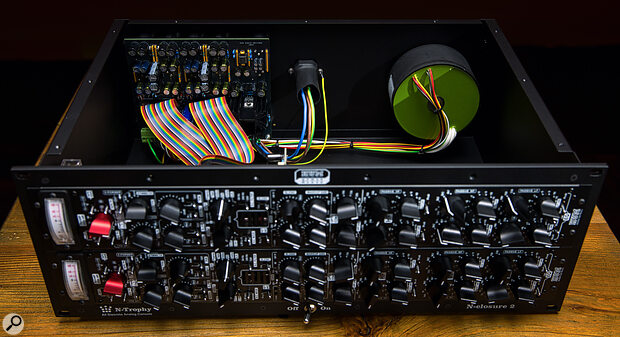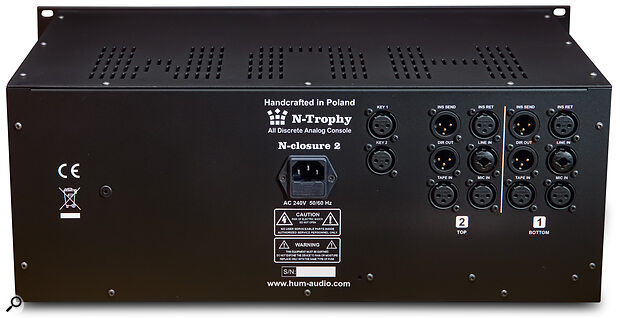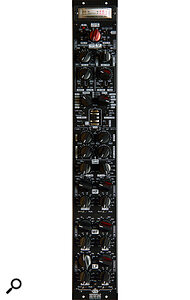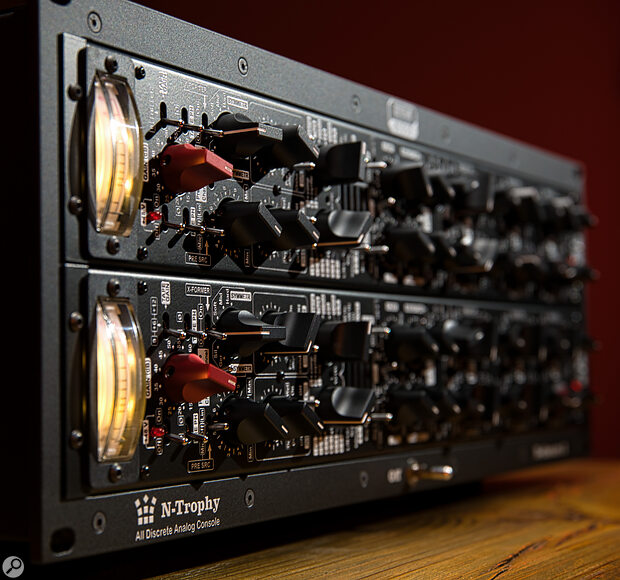Looking for the ultimate analogue channel strip, cost no object? Then check this out, while the rest of us dream!
Recording engineer and studio equipment designer Krzysztof Tonn opened TONN Studio in Łódź, Poland, back in 1999. Since 2014 this busy studio has also served as the R&D test facility for HUM Audio Devices, a company that Tonn co‑founded with Krzysztof Rudnicki. HUM design and hand‑assemble a range of high‑end boutique ribbon microphones and analogue hardware for recording, mixing and mastering. Tonn aims to deliver “the best possible sound quality together with exceptional creativity, musicality and practical functionality”. If you read our SOS February 2024 review of HUM’s LAAL look‑ahead analogue limiter, you’ll appreciate precisely what he means by that: it’s a no‑compromise, cost‑no‑object design approach.
Black & White Beauties
Their N‑TROPHY mixing console, first demonstrated at 2023’s GearFest UK event at London’s Tileyard Studios, is probably an even better illustration of that philosophy. We’ve not yet had the opportunity to evaluate that console, but HUM recently released the N‑STRIP, a standalone implementation of the N‑TROPHY’s input channel, minus the auxiliary sends and faders. It’s available in two forms: a horizontally mounted pair of channels sitting in a 4U 19‑inch rackmount frame called the N‑CLOSURE 2; and up to six channels vertically mounted in a six‑slot, 11U, 19‑inch rackmount chassis called the N‑CLOSURE 6.
 Both N‑STRIP enclosures (the N‑STRIP 2 is pictured) feature an internal linear power supply.
Both N‑STRIP enclosures (the N‑STRIP 2 is pictured) feature an internal linear power supply.
I was sent an N‑CLOSURE 2 for review but, other than the obvious size difference, the two black N‑CLOSURE frames have the same functionality, with an internal linear power supply based around a fully encapsulated toroidal mains transformer. Along with the mains power inlet, all the audio I/O (of which more below) is found on their rear panels.
All the I/O balanced, and is the same as on the console. The main inputs are an XLR input for mic signals, plus a combination XLR/quarter‑inch jack that, with a 10kΩ input impedance, can accept balanced or unbalanced line signals. There’s also a dedicated XLR tape input, intended primarily for a DAW/tape machine playback signal, but if using the N‑STRIP simply as a luxury ‘front end’ it could equally well serve as an alternative line input. Further balanced XLRs are used for the line‑level insert send/return loop, and for the Key 1 and Key 2 inputs to the built‑in optical compressor’s side‑chain circuit. The main output, again on XLR, is marked Dir Out, and can be switched on the front panel to be immediately post preamp or after all of the processing.
With just three exceptions — the mechanical VU meter at the top of the strip, the red preamp gain knob just below it, and the phantom power indicator — the colour scheme is entirely monochrome. The immense configurability of each 7cm‑wide channel means that a huge amount of information has had to be accommodated around the various toggle switches and machined aluminium knobs. Thankfully, the precision, clarity and legibility of the white legending is of a quality I’ve not previously encountered on any console. There’s similar attention to detail throughout, in fact. For example, both frames are equipped with a locking on/off toggle switch — a simple and effective solution to the age‑old problem of accidental on/off switching that I’ve not seen before.
 The N‑STRIP enclosures feature the same I/O as the channels on the N‑TROPHY console.
The N‑STRIP enclosures feature the same I/O as the channels on the N‑TROPHY console.
Preamp & Processing
 There’s an immense amount of control at your fingertips, and while that inevitably makes the panel somewhat busy‑looking at first glance, it’s all very clearly labelled and soon becomes intuitive.The N‑STRIP’s circuitry is fully discrete. It features only full‑size, through‑hole components and, to ensure the highest audio quality, an audio path that’s been designed to be as short as possible. The transformerless, Class‑A preamp is based on Deane Jensen’s JE‑990 discrete op‑amp. Jensen’s design took full advantage of the low noise and matching characteristics of the National Semiconductor LM394 Supermatch NPN pair, but that’s been discontinued, so Tonn’s version replaces them with the even lower‑noise Analog Devices SSM212 dual‑matched NPN transistor.
There’s an immense amount of control at your fingertips, and while that inevitably makes the panel somewhat busy‑looking at first glance, it’s all very clearly labelled and soon becomes intuitive.The N‑STRIP’s circuitry is fully discrete. It features only full‑size, through‑hole components and, to ensure the highest audio quality, an audio path that’s been designed to be as short as possible. The transformerless, Class‑A preamp is based on Deane Jensen’s JE‑990 discrete op‑amp. Jensen’s design took full advantage of the low noise and matching characteristics of the National Semiconductor LM394 Supermatch NPN pair, but that’s been discontinued, so Tonn’s version replaces them with the even lower‑noise Analog Devices SSM212 dual‑matched NPN transistor.
The preamp stage itself is transformerless and allows you to capture a very clean sound, but each channel also possesses a switchable, custom‑made inter‑stage transformer that means the...
You are reading one of the locked Subscribers-only articles from our latest 5 issues.
You've read 30% of this article for FREE, so to continue reading...
- ✅ Log in - if you have a Digital Subscription you bought from SoundOnSound.com
- ⬇️ Buy & Download this Single Article in PDF format £0.83 GBP$1.49 USD
For less than the price of a coffee, buy now and immediately download to your computer, tablet or mobile. - ⬇️ ⬇️ ⬇️ Buy & Download the FULL ISSUE PDF
Our 'full SOS magazine' for smartphone/tablet/computer. More info... - 📲 Buy a DIGITAL subscription (or 📖 📲 Print + Digital sub)
Instantly unlock ALL Premium web articles! We often release online-only content.
Visit our ShopStore.

